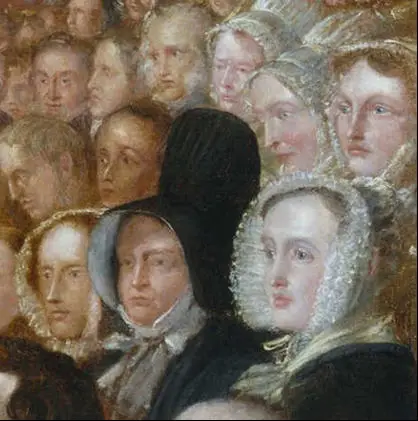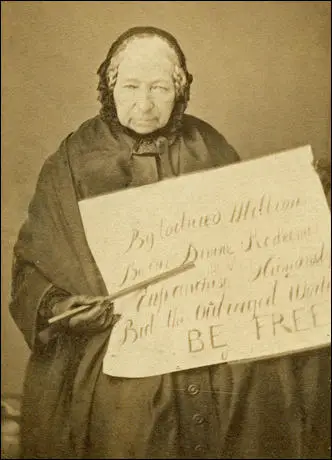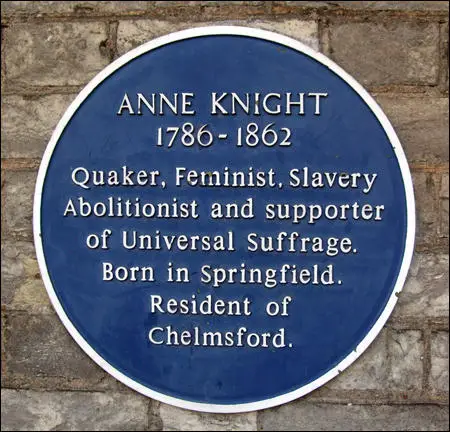Anne Knight
Anne Knight, the daughter of third of the eight children of wholesale grocer, William Knight (1786–1862), was born in Chelmsford on 2nd November 1781. Anne's mother was Priscilla Allen Knight (1753–1829), the daughter of William Allen, a well-known radical and Nonconformist. The Knight family were members of the Society of Friends and were pacifists and social reformers. (1)
Anne became active in the struggle against slavery and became a close friend of Elizabeth Heyrick and during the early 1820s sent each other pamphlets on social reform. They both favoured immediate rather than gradual abolition of the slave-trade. (2)
In 1824 Heyrick published her pamphlet Immediate not Gradual Abolition. In her pamphlet Heyrick argued passionately in favour of the immediate emancipation of the slaves in the British colonies. This differed from the official policy of the Anti-Slavery Society that believed in gradual abolition. She called this "the very masterpiece of satanic policy" and called for a boycott of the sugar produced on slave plantations. (3)
In the pamphlet Heyrick attacked the "slow, cautious, accommodating measures" of the leaders. "The perpetuation of slavery in our West India colonies is not an abstract question, to be settled between the government and the planters; it is one in which we are all implicated, we are all guilty of supporting and perpetuating slavery. The West Indian planter and the people of this country stand in the same moral relation to each other as the thief and receiver of stolen goods". (4)
Anne Knight and the Abolition of Slavery
The leadership of the organisation attempted to suppress information about the existence of this pamphlet and William Wilberforce gave out instructions for leaders of the movement not to speak at women's anti-slavery societies. His biographer, William Hague, claims that Wilberforce was unable to adjust to the idea of women becoming involved in politics "occurring as this did nearly a century before women would be given the vote in Britain". (5)
George Stephen disagreed with Wilberforce on this issue and claimed that their energy was vital in the success of the movement: "Ladies Associations did everything... They circulated publications; they procured the money to publish; they talked, coaxed and lectured: they got up public meetings and filled our halls and platforms when the day arrived; they carried round petitions and enforced the duty of signing them... In a word they formed the cement of the whole anti-slavery building - without their aid we never should have kept standing." (6)
On 8th April, 1825, Lucy Townsend held a meeting at her home to discuss the issue of the role of women in the anti-slavery movement. Townsend, Elizabeth Heyrick, Mary Lloyd, Sarah Wedgwood, Sophia Sturge and the other women at the meeting decided to form the Birmingham Ladies Society for the Relief of Negro Slaves (later the group changed its name to the Female Society for Birmingham). (7) The group "promoted the sugar boycott, targeting shops as well as shoppers, visiting thousands of homes and distributing pamphlets, calling meetings and drawing petitions." (8)
The society which was, from its foundation, independent of both the national Anti-Slavery Society and of the local men's anti-slavery society. As Clare Midgley has pointed out: "It acted as the hub of a developing national network of female anti-slavery societies, rather than as a local auxiliary. It also had important international connections, and publicity on its activities in Benjamin Lundy's abolitionist periodical The Genius of Universal Emancipation influenced the formation of the first female anti-slavery societies in America". (9)
Anne Knight was inspired by the Birmingham Ladies Society for the Relief of Negro Slaves for form a similar organisation in Chelmsford. Other groups were established in Nottingham (Ann Taylor Gilbert), Sheffield (Mary Anne Rawson, Mary Roberts), Leicester (Elizabeth Heyrick, Susanna Watts), Glasgow (Jane Smeal), Norwich (Amelia Opie, Anna Gurney), London (Mary Anne Schimmelpenninck, Mary Foster) and Darlington (Elizabeth Pease). By 1831 there were seventy-three of these women's organisations campaigning against slavery. (10)
In early 1833 Anne Knight joined forces with the London Female Anti-Slavery Society to organise a national women's petition against slavery. When it was presented to Parliament it was signed by 298,785 women. It was the largest single anti-slavery petition in the movement's history. (11)
The Slavery Abolition Act was passed on 28th August 1833. This act gave all slaves in the British Empire their freedom. The British government paid £20 million in compensation to the slave owners. The amount that the plantation owners received depended on the number of slaves that they had. For example, Henry Phillpotts, the Bishop of Exeter, received £12,700 for the 665 slaves he owned. (12)
In 1834 Anne Knight toured France where she gave lectures on the immorality of slavery. Knight argued for the immediate abolition of slavery without compensation in the rest of Europe. Later, her contribution to the anti-slavery campaign was recognised when a village for Jamaican freed slaves was named Knightsville. She was also active in the British and Foreign Anti-Slavery Society. (13)
World Anti-Slavery Convention
Anne Knight attended the World Anti-Slavery Convention held at Exeter Hall in London, in June 1840 but as a woman was refused permission to speak. She did meet two American delegates Elizabeth Cady Stanton and Lucretia Mott. Stanton later recalled: "We resolved to hold a convention as soon as we returned home, and form a society to advocate the rights of women." (14) Mott described Knight as "a singular-looking woman - very pleasant and polite". (15)
She became aware that the artist, Benjamin Robert Haydon, had started a group portrait of those involved in the fight against slavery. She wrote a letter to Lucy Townsend complaining about the lack of women in the painting. "I am very anxious that the historical picture now in the hand of Haydon should not be performed without the chief lady of the history being there in justice to history and posterity the person who established (women's anti-slavery groups). You have as much right to be there as Thomas Clarkson himself, nay perhaps more, his achievement was in the slave trade; thine was slavery itself the pervading movement." (16)
When the painting was completed it did not include Lucy Townsend or most of the leading female campaigners against slavery. Clare Midgley, the author of Women Against Slavery (1995) points out that as well as Anne Knight and Lucretia Mott, it does feature Elizabeth Pease, Mary Anne Rawson, Amelia Opie and Annabella Byron: "Haydon's group portrait is exceptional in that it does record the existence of women campaigners. Most other memorials did not. There are no public monuments to women activists to complement those to William Wilberforce, Thomas Clarkson and other male leaders of the movement... In the written memoirs of these men, women tend to appear as helpful and inspirational wives, mothers and daughters rather than as activists in their own right." (17)

showing from left to right, bottom row: Annabella Byron, Amelia Opie,
Mary Ann Rawson, top row, Anne Knight, Mrs John Beaumont and Elizabeth Pease.
Marion Reid published A Plea for Women in 1843. Knight was grateful that she had stated the case for greater equality but thought that the author had unestimated the abilities of women. Knight wrote on her own copy of the book that it was "excellent with the exception of the great folly" where she said that women faced natural barriers. Knight complained that women did not have natural barriers "but those placed equally before men." (18)
The behaviour of the male leaders at the World Anti-Slavery Convention inspired Knight to start a campaign advocating equal rights for women. (19) This included having gummed labels printed with feminist quotations that she attached to the outside of her letters. In 1847 she wrote a letter to Matilda Ashurst Biggs on the subject of gender equality. Later that year the letter was published and it is considered to be the first ever leaflet on women's suffrage. (20)
Knight wrote: "I wish the talented philanthropists in England would come forward in this critical juncture of our nation's affairs and insist on the right of suffrage for all men and women unstained with crime... in order that all may have a voice in the affairs of their country... Never will the nations of the earth be well governed until both sexes, as well as all parties, are fully represented, and have an influence, a voice, and a hand in the enactment and administration of the laws." (21)
Women's Suffrage
Knight also became active in the Chartist movement. However, she became concerned about the way women campaigners were treated by some of the male leaders in the organisation. She criticised them for claiming "that the class struggle took precedence over that for women's rights". (22) Knight wrote "can a man be free, if a woman be a slave." (23) In a letter published in the Brighton Herald in 1850 she demanded that the Chartists should campaign for what she described as "true universal suffrage". (24)
An anonymous leaflet was published in 1847. It has been persuasively argued that the author of the work was Anne Knight. In argued: "Never will the nations of the earth be well governed, until both sexes, as well as all parties, are fully represented and have an influence, a voice, and a hand in the enactment and administration of the laws". (25)
Knight also became involved in international politics. In 1848 she was the first French government elected by universal manhood suffrage repressed freedom of association. The decree prohibited women from forming clubs or attending meetings of associations. Knight published a pamphlet criticising this action: "Alas, my brother, is it then true that thy eloquent voice has been heard in the heart of the National Assembly expressing a sentiment so contrary to real republicanism? Can it be that thou hast really protested not only against women's rights to form clubs but also against their right to attend clubs formed by men?" (25a)

placard reads: "By tortured millions, By the Divine Redeemer,
Enfranchise Humanity, Bid the Outraged World, BE FREE".
At a conference on world peace held in 1849, Anne Knight met two of Britain's reformers, Henry Brougham and Richard Cobden. She was disappointed by their lack of enthusiasm for women's rights. For the next few months she sent them several letters arguing the case for women's suffrage. In one letter to Cobden she argued that it was only when women had the vote that the electorate would be able to pressurize politicians into achieving world peace. (26)
Anne Knight and Anne Kent established the Sheffield Female Political Association. Their first meeting was held in Sheffield in February, 1851. Later that year it published an "Address to the Women of England". This was the first petition in England that demanded women's suffrage. It was presented to the House of Lords by George Howard, 7th Earl of Carlisle. (27) The following year she was "forbidden to vote for the man who inflicts the laws I am compelled to obey - the taxes I am compelled to pay". She added that "taxation without representation is tyranny". (28)
Anne Knight, who never married, spent the last few years of her life in Waldersbach, a small village south-west of Strasbourg, where she lived in the former home of pastor Jean-Frédéric Oberlin (1740-1826), the founder of the Christian Socialist movement in France and a man she greatly admired.
Anne Knight died on 4th November, 1862. (29)

Primary Sources
(1) In 1848, the first French government elected by universal manhood suffrage repressed freedom of association. The decree prohibited women from forming clubs or attending meetings of associations. Anne Knight responded by writing an open letter, To Pastor Coquerel, protesting this action.
Alas, my brother, is it then true that thy eloquent voice has been heard in the heart of the National Assembly expressing a sentiment so contrary to real republicanism? Can it be that thou hast really protested not only against women's rights to form clubs but also against their right to attend clubs formed by men? Is all this true?
Is it possible that thou, a minister of religion, hast spoken a language so contrary to the commandments of thy "Divine Master," for thus I have heard thee call him. This divine Master has said: "Do unto others as thou wouldst have others do unto thee." Well then! Would thee like it if thee were forbidden to hold meetings and to uphold thy opinions there?
Oh! reflect on thy words. What terrible events have taken place since the letter I wrote to thee [in April] soliciting thee to place thy mind and thy voice in the service of women's emancipation. Dost thou remember what M. Legouvé said in one of his lessons on the first revolution? "It failed," he said, "because it was unjust toward women." Then think on this: Could the horrible massacres that took place a few days ago have taken place if the citizens, less preoccupied with their own egotistical interests, had proclaimed liberty for all men and all women? Wouldst thou be living under a state of siege? Ah! no. Thou knowest well that if a woman had been seated in the councils at man's side, these horrible events would never have occurred. With the clairvoyance and the sentiment of justice that moves women, they would have opposed such measures, which they foresaw from the beginning would lead to such dreadful consequences. As long as this great injustice toward women remains, misery and insurrection will persist.
Hasten then, I beg thee, in the name of thy beloved fatherland, and also in the name of my country, poor England! Demand that the disinherited women of the nation be reintegrated into the rights enjoyed by the women of the Gauls, rights that were not denied to my Anglo-Saxon ancestors in 1515, if history is to be believed. Cast away this awful yoke of prejudice; mount the steps of this tribune, I beg thee, dressed in the armor of the just, like a Christian warrior! Protest in the name of the rights of humanity, without distinction of garb...
Sound the retreat, so that all devoted men can hear thee and, following the example of the noble archbishop of Paris, mount the barricades, proclaim the law of peace, prepare the happiness of thy nation and, thereby, of the earth. Then thou wilst have raised the true tricolor flag destined to circle the world with its slogan: Liberty, equality, fraternity - justice, compassion, and truth.
(2) Anne Knight, letter to Matilda Ashurst Biggs (April 1847)
I wish the talented philanthropists in England would come forward in this critical juncture of our nation's affairs and insist on the right of suffrage for all men and women unstained with crime... in order that all may have a voice in the affairs of their country... Never will the nations of the earth be well governed until both sexes, as well as all parties, are fully represented, and have an influence, a voice, and a hand in the enactment and administration of the laws.
(3) Anne Knight, letter published in the Brighton Herald (9th February, 1850)
It is justice that we demand for all who bear their share in the burdens of the State, and who does not pay taxes in this miserably tax-ground country? Is she exempt whose part it is to work 18 hours out of 24, to sleep little, and to be too much worn with labour to think.
Student Activities
Child Labour Simulation (Teacher Notes)
The Chartists (Answer Commentary)
Women and the Chartist Movement (Answer Commentary)
Road Transport and the Industrial Revolution (Answer Commentary)
Richard Arkwright and the Factory System (Answer Commentary)
Robert Owen and New Lanark (Answer Commentary)
James Watt and Steam Power (Answer Commentary)
The Domestic System (Answer Commentary)

